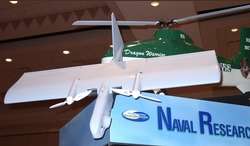 The Defense Department has unveiled a billion
dollar roadmap for unmanned aerial vehicles during the next 25
years. Plans call for developing joint interoperable UAVs that are
capable of everything from surveillance to air strike. "The roadmap
provides those high priority investments necessary to move UAV
capability to the mainstream," said Dyke Weatherington, deputy of
the UAV Planning Task Force in the Office of the Secretary of
Defense, at a DoD press briefing today. "The potential value UAVs
offer range across virtually every mission area and capability of
interest to DoD. The roadmap identifies those key technology areas
that we think are right for investment."
The Defense Department has unveiled a billion
dollar roadmap for unmanned aerial vehicles during the next 25
years. Plans call for developing joint interoperable UAVs that are
capable of everything from surveillance to air strike. "The roadmap
provides those high priority investments necessary to move UAV
capability to the mainstream," said Dyke Weatherington, deputy of
the UAV Planning Task Force in the Office of the Secretary of
Defense, at a DoD press briefing today. "The potential value UAVs
offer range across virtually every mission area and capability of
interest to DoD. The roadmap identifies those key technology areas
that we think are right for investment."
The Pentagon has made UAV weapon systems a priority. Defense
Secretary Donald Rumsfeld, who strongly supports the UAV program,
has pushed UAVs as one way to transform the military. Today, about
90 UAVs support military operations around the world, and the
department has them standing by for potential use over Iraq.
 By
2010, according to the roadmap report, DoD hopes to increase its
UAV inventory to about 350. And the department plans to increase
that to more than a thousand in the outyears, according to
Weatherington. From 1991 to 1999 the Pentagon invested about $3
billion in UAV projects. That is projected to rise to $10 billion
from today through 2010, according to the latest DoD Unmanned
Aerial Vehicles Roadmap 2002-2027 report.
By
2010, according to the roadmap report, DoD hopes to increase its
UAV inventory to about 350. And the department plans to increase
that to more than a thousand in the outyears, according to
Weatherington. From 1991 to 1999 the Pentagon invested about $3
billion in UAV projects. That is projected to rise to $10 billion
from today through 2010, according to the latest DoD Unmanned
Aerial Vehicles Roadmap 2002-2027 report.
The Air Force's Predator UAV proved its military capability
flying reconnaissance missions in Bosnia, and was credited with
taking out one of al Qaeda's top lieutenants in Afghanistan with a
Hellfire missile.
Besides Predator, the military services are developing other UAV
platforms. For example, the Air Force has another UAV called Global
Hawk. The system is completely computer-operated and can be used
for long-term surveillance. The high-flying Global Hawk currently
carries photo reconnaissance equipment, but production versions of
the system will carry electronic intelligence gathering materials.
The Global Hawk can stay airborne for 32 hours.
The Army has developed the Shadow 200 tactical UAV. The Army
also has the Hunter UAV, and both are primary surveillance UAVs and
relay video in real time.
 Meanwhile, the Marine Corps has developed Dragon
Eye, a small, hand-launched UAV that can give leaders a snapshot of
the battlefield, and it plans to make improvements to the Pioneer
UAV developed by the Navy. The Pioneer was used in the 1991 Gulf
War.
Meanwhile, the Marine Corps has developed Dragon
Eye, a small, hand-launched UAV that can give leaders a snapshot of
the battlefield, and it plans to make improvements to the Pioneer
UAV developed by the Navy. The Pioneer was used in the 1991 Gulf
War.
The Navy is developing Neptune, which can drop small payloads
and the X-46/X-47, a large autonomous unmanned combat aerial
vehicle that has a 34-foot wingspan. The system will be initially
built for tactical surveillance, but the Navy envisions it one day
becoming a strike system.
Weatherington said that UAVs offer a unique advantage for
military leaders because they can conduct dangerous mission without
the risk of human life. UAVs will soon have the capability for
reconnaissance in areas possibly contaminated with biological or
chemical agents or suppress enemy air defenses, or provide deep
strike interdiction, he said.
 Sierra Space Repositions Dream Chaser for First Mission
Sierra Space Repositions Dream Chaser for First Mission ANN's Daily Aero-Term (05.10.24): Takeoff Roll
ANN's Daily Aero-Term (05.10.24): Takeoff Roll Aero-News: Quote of the Day (05.10.24)
Aero-News: Quote of the Day (05.10.24) Aero-News: Quote of the Day (05.11.24)
Aero-News: Quote of the Day (05.11.24) ANN's Daily Aero-Term (05.11.24): IDENT Feature
ANN's Daily Aero-Term (05.11.24): IDENT Feature





